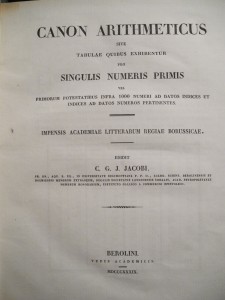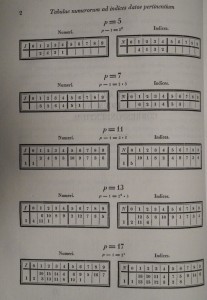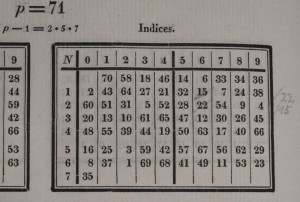Because I was teaching a course on prime numbers this semester and had just finished a chapter on Vinogradov’s method when his paper appeared, I promptly switched my plans for the last classes in order to present some aspects of Yitang Zhang’s theorem on bounded gaps between primes. In addition, one of the speakers of this week’s conference celebrating 25 years of the “Zahlentheorie Seminar” of ETH had to cancel at short notice, and I replaced her and gave yesterday another survey-style talk. The notes for the latter (such as they are…) can be downloaded in scanned form.
My insights to Zhang’s work remain clearly superficial, but here are some remarks going a bit beyond what I mentioned in the previous post, coming after these lectures, and some discussions with Ph. Michel and P. Nelson.
(1) The most delicate estimates seem to be those for the “Type III” sums. These concern the “good” distribution in invertible residue classes of an arithmetic function for integers
, modulo a "large modulus"
, where
is of the very special type
and the variables ,
,
and
are, roughly, of size
,
with
, and (crucially)
is a bit larger than
: one needs to handle these for
up to
for some
in order to obtain bounded gaps between primes.
The lengths and
are constrained in various ways, and the most critical case seems to be when
,
(the
means that one must be able to go a bit beyond such a case, since
is a bit beyond
).
(2) Another point is that Zhang manages to bound these sums for each individual residue class (coprime to
). In other words, denoting
he proves individual bounds for , instead of average bounds over
(as in the other main part of this argument).
Also, he does not need to use the variable at all (but since the
are mostly unknown coefficients, and the sum is rather short, exploiting it does not seem easy). Hence the result looks enormously like controlling the distribution in residue classes of the ternary divisor function. This is exactly the question that Friedlander and Iwaniec had studied in the famous paper where they proved that the exponent of distribution is at least
, but their argument is not quite sufficient for Zhang's purpose.
(3) One of the last tricks is Zhang's second use of the structure of the moduli that are involved in his argument: these were chosen to have only prime factors
for some small positive
), and Zhang exploits the "granular" (or friable) structure of such moduli in order to obtain flexibility in the possibility of factoring them as
with
of size determined up to a factor at most
. This is particularly important for the “other” sums (it gives bilinear structure and makes it possible to use the dispersion method of Linnik, as already done by Fouvry-Iwaniec and Bombieri-Friedlander-Iwaniec in their works on primes in arithmetic progressions). For the "type III" case, it does not seem to be so much of the essence, but Zhang needs to gain a very small amount compared with Friedlander-Iwaniec, and does so by factoring
with
rather small. He then gains from
a factor
which is essential, by exploiting the fact that a Ramanujan sum modulo
is bounded (so he gets more than square-root cancellation from
…)! This is an extremely special situation, and right now, it is what seems the most “miraculous” about this proof (at least to me).
It is for the contribution of the complementary divisor that Zhang manages to position himself into applying the estimate of Birch and Bombieri for the exponential sums which Friedlander-Iwaniec had also encountered.
(4) This use of Deligne’s work is also very delicate: one can not relax the requirement of square-root cancellation, except by very tiny amounts. For instance, obtaining a bound of size for the three-variable sum modulo
is useless; in fact, the bound
can be considered here as the trivial estimate, since the sum can be written as an average of one-variable Kloosterman sums. With Zhang’s parameters, one needs an estimate of for the sum which is no larger than
(or so) in order to get the desired gain. However, as I explained in the last five minutes of my talk today (and as is explained in this note with Fouvry and Michel) the Birch-Bombieri bound is very well understood from a conceptual point of view.
(5) I was very curious, when first looking at the paper, to see how Zhang would handle the residue classes in the Goldston, Pintz, Yıldırım method, since the most uniform results on primes in arithmetic progressions (those of Fouvry-Iwaniec and Bombieri-Friedlander-Iwaniec) are constrained to use (essentially) a single residue class. What happens is that Zhang detects these classes by inserting a factor corresponding to their characteristic function, and by avoiding the Kloostermania approaches that rely on spectral theory of automorphic forms. The important properties of these residue classes are their multiplicative structure (coming from the Chinese Remainder Theorem) and the fact that, on average over moduli, there are not too many of them (the average is bounded by a power of ). In particular, his use of the dispersion method is in fact closer in spirit to some of its earliest uses by Fouvry and Iwaniec (for integers without small prime factors instead of primes), which also involved, in the final steps, the classical Weil bound for Kloosterman sums instead of (seemingly stronger) results on sums of Kloosterman sums.






